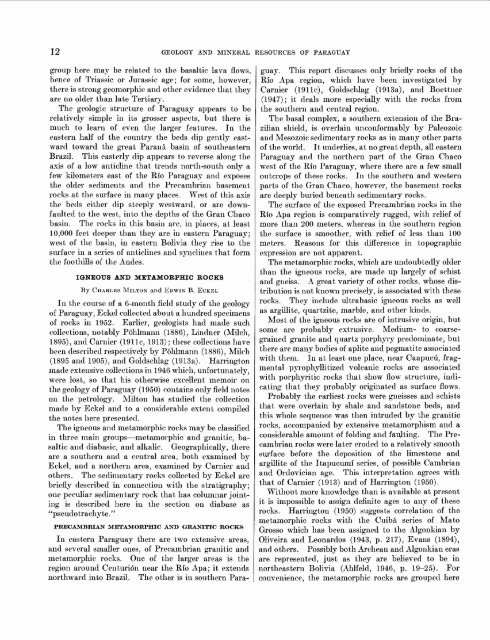Geology and Mineral Resources of Paraguay A Reconnaissance
Geology and Mineral Resources of Paraguay A Reconnaissance
Geology and Mineral Resources of Paraguay A Reconnaissance
- No tags were found...
Create successful ePaper yourself
Turn your PDF publications into a flip-book with our unique Google optimized e-Paper software.
12 GEOLOGY AND MINERAL RESOURCES OF PARAGUAYgroup here may be related to the basaltic lava flows,hence <strong>of</strong> Triassic or Jurassic age; for some, however,there is strong geomorphic <strong>and</strong> other evidence that theyare no older than late Tertiary.The geologic structure <strong>of</strong> <strong>Paraguay</strong> appears to berelatively simple in its grosser aspects, but there ismuch to learn <strong>of</strong> even the larger features. In theeastern half <strong>of</strong> the country the beds dip gently eastwardtoward the great Parana basin <strong>of</strong> southeasternBrazil. This easterly dip appears to reverse along theaxis <strong>of</strong> a low anticline that trends north-south only afew kilometers east <strong>of</strong> the Rio <strong>Paraguay</strong> <strong>and</strong> exposesthe older sediments <strong>and</strong> the Precambrian basementrocks at the surface in many places. West <strong>of</strong> this axisthe beds either dip steeply westward, or are downfaultedto the west, into the depths <strong>of</strong> the Gran Chacobasin. The rocks in this basin are, in places, at least10,000 feet deeper than they are in eastern <strong>Paraguay</strong>;west <strong>of</strong> the basin, in eastern Bolivia they rise to thesurface in a series <strong>of</strong> anticlines <strong>and</strong> syncliiies that formthe foothills <strong>of</strong> the Andes.IGNEOUS AND METAMOBPHIC BOCKSBy CHARLES MILTON <strong>and</strong> EDWIN B. ECKELIn the course <strong>of</strong> a 6-month field study <strong>of</strong> the geology<strong>of</strong> <strong>Paraguay</strong>, Eckel collected about a hundred specimens<strong>of</strong> rocks in 1952. Earlier, geologists had made suchcollections, notably Pohlmaim (1886), Lindner (Milch,1895), <strong>and</strong> Cariiier (1911c, 1913); these collections havebeen described respectively by Pohlmann (1886), Milch(1895 <strong>and</strong> 1905), <strong>and</strong> Goldschlag (1913a). Harringtonmade extensive collections in 1946 which, unfortunately,were lost, so that his otherwise excellent memoir onthe geology <strong>of</strong> <strong>Paraguay</strong> (1950) contains only field noteson the petrology. Milton has studied the collectionmade by Eckel <strong>and</strong> to a considerable extent compiledthe notes here presented.The igneous <strong>and</strong> metamorphic rocks may be classifiedin three main groups metamorphic <strong>and</strong> granitic, basaltic<strong>and</strong> diabasic, <strong>and</strong> alkalic. Geographically, thereare a southern <strong>and</strong> a central area, both examined byEckel, <strong>and</strong> a northern area, examined by Carnier <strong>and</strong>others. The sedimentary rocks collected by Eckel arebriefly described in connection with the stratigraphy;one peculiar sedimentary rock that has columnar jointingis described here in the section on diabase as' 'pseudotrachy te.''PRECAMBRIAN METAMORPHIC AND GRANITIC ROCKSIn eastern <strong>Paraguay</strong> there are two extensive areas,<strong>and</strong> several smaller ones, <strong>of</strong> Precambrian granitic <strong>and</strong>metamorphic rocks. One <strong>of</strong> the larger areas is theregion around Centurion near the Rio Apa; it extendsnorthward into Brazil. The other is in southern <strong>Paraguay</strong>.This report discusses only briefly rocks <strong>of</strong> theRio Apa region, which have been investigated byCarnier (1911c), Goldschlag (1913a), <strong>and</strong> Boettner(1947); it deals more especially with the rocks fromthe southern <strong>and</strong> central region.The basal complex, a southern extension <strong>of</strong> the Brazilianshield, is overlain unconformably by Paleozoic<strong>and</strong> Mesozoic sedimentary rocks as in many other parts<strong>of</strong> the world. It underlies, at no great depth, all eastern<strong>Paraguay</strong> <strong>and</strong> the northern part <strong>of</strong> the Gran Chacowest <strong>of</strong> the Rio <strong>Paraguay</strong>, where there are a few smalloutcrops <strong>of</strong> these rocks. In the southern <strong>and</strong> westernparts <strong>of</strong> the Gran Chaco, however, the basement rocksare deeply buried beneath sedimentary rocks.The surface <strong>of</strong> the exposed Precambrian rocks in theRio Apa region is comparatively rugged, with relief <strong>of</strong>more than 200 meters, whereas in the southern regionthe surface is smoother, with relief <strong>of</strong> less than 100meters. Reasons for this difference in topographicexpression are not apparent.The metamorphic rocks, which are undoubtedly olderthan the igneous rocks, are made up largely <strong>of</strong> schist<strong>and</strong> gneiss. A great variety <strong>of</strong> other rocks, whose distributionis not known precisely, is associated with theserocks. They include ultrabasic igneous rocks as wellas argillite, quartzite, marble, <strong>and</strong> other kinds.Most <strong>of</strong> the igneous rocks are <strong>of</strong> intrusive origin, butsome are probably extrusive. Medium- to coarsegrainedgranite <strong>and</strong> quartz porphyry predominate, butthere are many bodies <strong>of</strong> aplite <strong>and</strong> pegmatite associatedwith them. In at least one place, near Caapucii, fragmentalpyrophyllitized volcanic rocks are associatedwith porphyritic rocks that show flow structure, indicatingthat they probably originated as surface flows.Probably the earliest rocks were gneisses <strong>and</strong> schiststhat were overlain by shale <strong>and</strong> s<strong>and</strong>stone beds, <strong>and</strong>this whole sequence was then intruded by the graniticrocks, accompanied by extensive metamorphism <strong>and</strong> aconsiderable amount <strong>of</strong> folding <strong>and</strong> faulting. The Precambrianrocks were later eroded to a relatively smoothsurface before the deposition <strong>of</strong> the limestone <strong>and</strong>argillite <strong>of</strong> the Itapucumi series, <strong>of</strong> possible Cambrian<strong>and</strong> Ordovician age. This interpretation agrees withthat <strong>of</strong> Carnier (1913) <strong>and</strong> <strong>of</strong> Harrington (1950).Without more knowledge than is available at presentit is impossible to assign definite ages to any <strong>of</strong> theserocks. Harrington (1950) suggests correlation <strong>of</strong> themetamorphic rocks with the Cuiba series <strong>of</strong> MatoGrosso which has been assigned to the AJgonkian byOliveira <strong>and</strong> Leonardos (1943, p. 217), Evans (1894),<strong>and</strong> others. Possibly both Archean <strong>and</strong> Algonkian erasare represented, just as they are believed to be innortheastern Bolivia (Ahlfeld, 1946, p. 19-25). Forconvenience, the metamorphic rocks are grouped here
















